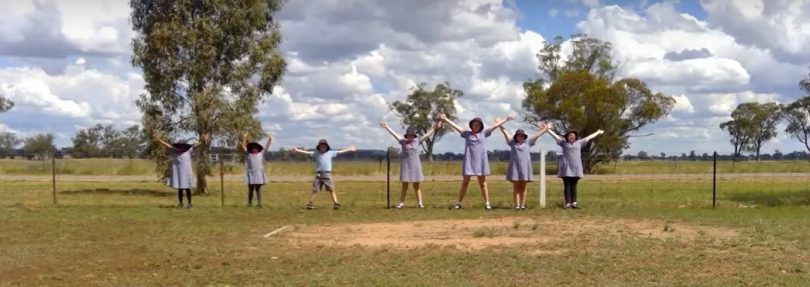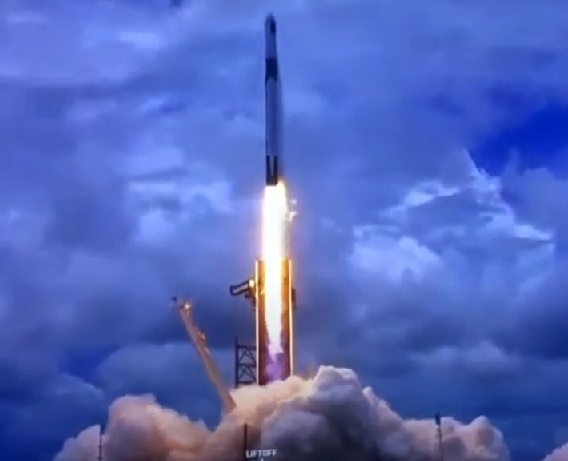
A video was prepared as part of the submission for the “What’ll happen with the wattle??!” program, with Bribbaree Public School students wishing to pay tribute to the school gardener Paul “Boss” Harris who passed away in 2021. Photo: Bribbaree Public School.
What do the International Space Station and the students of Bribbaree Public School have in common?
Bribbaree is a tiny village of 141 people situated an hour west of Young in the NSW South West Slopes. It’s heaving with 104 years of history and, despite an abating population, it’s still hanging in there thanks to a pub, a bowling club, smash repairs, farm ag business and, come harvest, the servo extends its range to offer sandwiches to the hungry hordes of truck drivers waiting to deliver grain to the local silo.
It could be said that for much of the year the local school is the hive of most activity and last year its seven students were lucky enough to be selected to participate in an experiment that took them to outer space.

The moment the wattle seeds were launched into space. The students were able to witness the journey of the seeds from the International Space Station and their return to earth. Photo: One Giant Leap Australia Foundation.
What better way to pay tribute to their popular long-time gardener and Quandialla local Paul “Boss” Harris – who passed away in 2021.
So, in a spot completely surrounded by agriculture, the students turned their hands to becoming space farmers through an organisation called the One Giant Leap Australia Foundation.
The not-for-profit foundation’s purpose is to advance STEM education and careers by providing life-changing opportunities for students and educators to develop and build their knowledge and understanding of science, technology, engineering and mathematics.
In a first for Australia, with the support of the Australian Space Agency and in collaboration with JAXA (Japan Aerospace Exploration Agency), One Giant Leap sent golden wattle seeds to the International Space Station.
The seeds lived in space for seven months from December 2020 to July 2021 before being distributed to more than 300 locations nationally.
The “What’ll happen with the wattle??!” program was offered to more than 150 schools, scout groups and Australian Air Force cadets across Australia.
The chosen schools around Australia received wattle seeds that have flown to space, plus seeds that have not. All seeds are from the same seed lot.
Students are then asked to germinate and grow their seeds, recording data about the germination and seed growth. Data is then uploaded to the ‘What’ll happen to the wattle??!’ app with One Giant Leap Australia Foundation running teleconferences and providing educational support to participating groups.

The man the students are remembering through a tribute garden – Paul “The Boss” Harris. Photo: Bribbaree Public School.
The 12-month to two year project will result in the creation of a nationwide map identifying the location of Australia‘s ‘space wattle’ trees.
A community panel judged the applications each comprising 200 words and a short video, explaining what the schools would do with the wattle once it had grown.
As one of the panel members said, “We have spent five days watching videos. Entries from all over Australia. From a single teacher in a face mask in a school in Victoria to a small school in remote Northern Territory. It has been an amazing opportunity to laugh and cry our way through them.”
Bribbaree Public School got the golden ticket. Little did they know their tale would be one of patience and tenacity, with a few complications.
According to principal Craig McMahon, each day Bribbaree Public School has a focus on the environment.
“We are always working in our kitchen garden and we also propagate plants for the garden,” he said.
COVID lockdowns suspended all activity, which was fortunate as the seeds, having been to outer space and back, were now stuck in transit. Which did not involve a spacecraft of any nature.
Early October’s resumption of face-to-face teaching was a giant leap for the returning students as the packaged seeds had finally arrived, ready for germination.

The spot selected for Boss’s tribute garden. Photo: Bribbaree Public School.
But every tale has a twist and for Craig it was one that tested his mettle.
“Our first germination was a fail,” he said, “so I visited a local nursery and got specific advice”.
Brandishing a new set of seeds Craig and the students had another go.
“To-date no success,” he reported to About Regional last week.
“I was under the impression the seeds would germinate but it seems the ones from earth are no different from those that went to space.”
So as the school farewelled their Year 6 students and closed its doors on 2021, it was the principal who was grappling disappointment.
But he isn’t giving up.
“We will source seeds from the local native nursery and keep trying,” he said.
Meanwhile up in the International Space Station, the propagation of sweet and holy basil is underway for the Asian Herbs in Space program, with that experiment to return to Earth for detailed investigations such as morphological, scent and gene expression analysis.







